
Mars Up Close
Ever since Spirit and Opportunity began relaying images and data from Mars in January 2004,
geologists following their explorations from Earth have employed a lexicon unusual for
scientists, referring to martian "blueberries," "popcorn," and "deep-fried," "batter-coated"
blobs, among other things. Because the intrepid Mars Exploration Rovers are discovering a
landscape littered with formations experts have never dreamed of let alone seen before,
they've rapidly developed new terminology and new perspectives on the central question
of the mission: Did liquid water ever flow on Mars? In this narrated tour, allow Steve
Squyres, the mission's principal science investigator, to guide you through a handful
of each rover's most stunning and outlandish finds and hear for yourself the many reasons
why scientists now feel certain that Mars did indeed have a wet past.—Lexi Krock and David Levin
Note: To learn more about the Mars rovers and their suite of scientific tools, see Anatomy of a Rover. To calculate the U.S. customary weight and measurement equivalents from the metric system Steve Squyres uses below, see our conversion chart.
Spirit Rover
 |
 |
 |
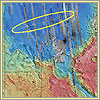

| |
Gusev Crater
"This is the landing site for the Spirit rover. It's in a place called Gusev
Crater. Gusev we picked because it's a big hole in the ground with a dried-up
riverbed flowing into it. It's a crater about 160 kilometers in diameter. The
thing that's special about it is that flowing into the southern side of the
crater, breaching its rim, there is an ancient channel. And it's a clear
indicator, we think, that there must have once been a lake there long ago. We
went to Gusev in hopes of finding sediments that had been laid down long ago in
a lake. It turned out what we got was a bit different from that. But that's
what we went looking for."
|
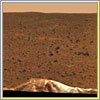

| |
Spirit on Mars
"This is the first good view that we got of the surface of Mars with
Spirit after we landed. This picture was taken while we were still on
the lander. We went to Gusev hoping to find ancient lake-bed deposits. We
looked around and, boy, it looked really smooth; it looked really flat. And we
thought, "Yeah, this is what a martian dry lake bed looks like." As we looked
more carefully, though, we began to realize that maybe we hadn't quite found
what we had come looking for. The rocks didn't seem to show sedimentary
layering. They looked like they might be volcanic rocks. With time, we came to
realize that what we had hoped to find at Gusev Crater was going to be a bit
more elusive than we had originally realized. Mars had sort of faked us out."
|
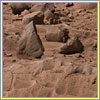

| |
Mazatzal
"When we first landed, we took a look around and we saw a bunch of rocks. They
looked suspiciously like volcanic rocks despite the fact that we were expecting
sedimentary rocks. And this was sort of a disappointment. But there was a hope
among many people on the team that they might be something different—that
they could be a limestone, that they could be sulfates, that they could be
something exotic, something really different. So the one that we picked was the
rock called Mazatzal. We spent eight or nine or ten days at Mazatzal; it was
certainly more than a week. And we drilled a hole in it with our RAT. We
brushed the surface of it. We really cleaned it off and looked at it in detail.
But when we ground through that with our rock abrasion tool and looked
underneath, it was just regular old basalt, just like everything else."
|
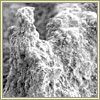

| |
Pot of Gold
"Pot of Gold was a strange one. We landed on these flat plains covered with
lavas. And when we landed we could see off in the distance a beautiful range of
hills called the Columbia Hills. So after about 100 or so days of looking at
the plains, we decided we were going to just put the pedal down and go as fast
as we could and try to get over to the hills before the rover died. We got to
the base of the hills and everything changed. Suddenly we found ourselves
among geologic materials completely different from everything that we had seen
out on the plains. And the first rock that we got a good look at in the hills
was Pot of Gold. I've got to be honest with you: we still don't really
understand this rock. It's got this bizarre texture. It's got these little
tentacle-like things sticking out of it. A couple of things about it have
suggested to us that it did form as the result of action or interaction with
liquid water. One is that when you look at the chemistry of this thing, it is
fairly rich in some elements like sulfur and chlorine. It's also got this
mineral hematite in it, which is sometimes formed as the result of action of
water as well. I wish that I understood it better than I do, and I wish we
would find some more rocks like it. But, so far, it is strictly one of a
kind."
|
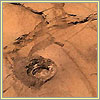

| |
Clovis
"We got to the base of the Columbia Hills. We took a look around and we realized
that up the hill from us there appeared to be outcrops of real bedrock. And to
a geologist bedrock is very important so we were really seeking bedrock.
"We had to fight to get to Clovis. Our vehicles were not designed for
mountaineering. So when we got to the Columbia Hills, we didn't even know if we
could get up them. We got up to Clovis, though, and there, finally, we found
ourselves on bedrock. It turned out to be totally different from anything that
we saw out on the plains. We put a hole in this thing, and we looked at it with
our microscope. And then we stuck our spectrometers in. And they found a rock
that had lots of sulfur in it, lots of chlorine in it, lots of bromine in it,
lots of phosphorous—a number of different elements that are commonly
formed in minerals that are easily transported by water. Now if you find all of
these elements concentrated in a rock, that's a sign that water interacted with
this rock. We've got a number of different clues that the bedrock of the
Columbia Hills has, in fact, interacted with water."
|
Opportunity Rover
 |
 |
 |
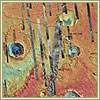

| |
Meridiani Planum
"Meridiani Planum. That's where Opportunity landed. It's very different
from the Spirit landing site. The thing that drew us to Meridiani was
not the topography. What drew us here was the composition of the surface.
There's an infrared spectrometer on a spacecraft called Mars Global Surveyor
that looked down from orbit and made a map of the chemistry of the surface of
Mars. And in this location, and in very few others, that infrared spectrometer
discovered the presence of a mineral called hematite. It is a mineral that
often—not always—but often, forms as a result of the action of
liquid water. It was a gamble. There are other ways to make hematite, too,
that don't involve water. So we didn't know what we were going to find here.
But we had a hint, visible from orbit, that this was a place where water might
have once been."
|
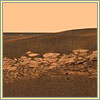

| |
Opportunity on Mars
"Wow!
Boy, this brings back some memories. This was a miracle. We landed at the
Meridiani site with Opportunity not knowing what we would see and
expecting it to look different from anything else on Mars before. My biggest
fear at Meridiani was that we would land on flat, sandy plains and there'd be
nothing to see in every direction—no rocks, just sand as far as the eye
could see. In fact, what happened was we hit the ground and we bounced. We
bounced and bounced with our air bags and we bounced and we rolled and we
rolled and we rolled right into a little 20-meter impact crater, right into it.
I mean Tiger Woods could not have done this. We opened our eyes, and the very
first picture—the absolute first picture to come down from the
spacecraft—showed layered bedrock eight meters away from us. It was
astonishing. And what we came to realize as we began to look at this bedrock in
more detail was that the layering preserved a record of conditions that had
existed at Meridiani Planum a long time ago. And it was then our job to try to
read that record and figure out what had actually happened here."
|
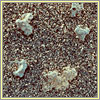

| |
Blueberries
"When
we first looked down at the soil of Meridiani with our cameras, we noticed that
it was covered with what sort of looked like gravel all around the vehicle. And
when we looked at them closely, some of them—a lot of them—seemed
to be really kind of spherical. So we rolled off the lander and down onto the
soil. And we whipped out our microscope and we took our very first picture of
the soil in front of the lander. In that image there were two objects that were
astonishingly round. I mean these things were spherical. And all of a sudden we
realized, "Hey, we're dealing with something really odd here." This is the one
that kind of rocked us back on our heels and made us think, "We got a situation
on our hands that's going to be very, very difficult to figure out here. But it
may be something really special." Though, boy, I'll tell you, when we saw this
one we didn't know what it was. We just did not know what we were dealing with
yet."
|
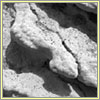

| |
Inside an Outcrop
"After taking a look at the spherical objects on the soil in front of us and
realizing that the soil was just covered with these things, we decided to drive
over and look at the outcrop. And this is a microscopic imager picture of the
rock in front of us. It's only about three centimeters across. And it revealed
to us our next astonishing discovery and that is that these little spherical
objects are embedded in the rock, like blueberries in a muffin. That's when we
started calling them blueberries. The rock erodes away and gets sand-blasted
over time. And then these hard blueberries erode out of the rock and tumble
down the slope, where you find them on the soil. And so now we knew where the
blueberries were coming from. We didn't know what they were yet, but at least
we knew where they were coming from."
|
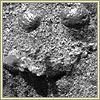

| |
Trench
"This
is a trench. We didn't bring a shovel with us. You know, it would be nice to be
able to drill deep holes. We didn't have that capability on this vehicle. But
we did have the capability to dig trenches in the soil using the wheels. We
sort of drive the rover back and forth, working one wheel down into the soil
and digging a trench that is about 15 centimeters deep. What the trench showed
us was a profile through the soil. And we didn't know how these blueberries
were distributed in the soil. There were certainly a lot on the top. We were
wondering if it was densely packed with blueberries all the way down. And, in
fact, it is not. The soil is mostly just basaltic sand—sand with the
composition of basalt. And then it turns out that it's just got a layer of
these blueberries sprinkled on top but very few of them in the soil below."
|
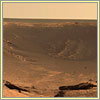

| |
Endurance Crater
"About 700 meters away from where we landed, there was a much larger crater, one
that we named Endurance Crater. It is about 150 meters in diameter and about 20
meters deep. We had pictures from orbit that suggested that it had layered
rocks exposed in its crater wall. Now if that was the case, that meant that we
could use those layers to see what had come before the watery conditions that
we had discovered over at Eagle crater. We went down into Endurance crater and
what we found there was, in fact, that these layered rocks extend for many,
many meters down. It seems to be blueberry-laden, sulfate salt-rich rocks all
the way down—for like ten meters down into this crater. So what that says
is that the period of water activity was significantly longer. It was more
water. It was a longer duration. It was a habitable environment for much longer
than just the rocks at Eagle reveal."
|
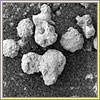

| |
Popcorn
"When we got deep down into Endurance Crater, we found a lot of things changed.
The chemistry changed; the texture of the rocks changed; and the blueberries
changed. Up in the upper regions of the crater, the blueberries were nice,
clean, perfectly round hematite spheres. You get down in the crater and you see
this stuff that doesn't look like these perfect spheres anymore. It looks
almost like popcorn or berries that have been sort of dipped in batter and
deep-fried. I don't know what's going on here. They appear to have some kind of
coating on the outside of them. When you look at these spherical objects deeper
down in the crater, you get a sense that many of them are conventional
blueberries (if you could use such a phrase), similar to the ones that we see
up the slope. But they've got a coating of salts on the outside of them. And
we don't entirely understand this yet. We are still trying to figure out what
happened here."
|
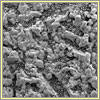

| |
El Capitan
"This is a close-up of a rock that we called El Capitan. This is one of the
first rocks that we looked at up close in Eagle Crater. You can see the fine
laminations, the layering in the rock. You can see some embedded blueberries.
And then there is something else in this one, too. And this was an intriguing
thing about this rock. There are a number of places in this rock where it is
cut through by little gashes in the rock, and they cut through the rock in all
sorts of crazy angles. They are typically maybe a centimeter or so in their
length, maybe a millimeter or two wide. And these are things that on Earth form
when you have crystals of some mineral. Crystals grow in place if the rock is
saturated with water, pushing aside or replacing the minerals that are there.
So now you have these tabular crystals all through the rock. And then something
changes. The water chemistry changes and the crystals dissolve away, or simply
it dries up and over eons erosion erodes away the softer crystal, leaving a
hole in the rock around it. So these weird tabular-shaped holes in the rock
were another hint that water was involved in the formation of these rocks."
|
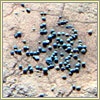

| |
Berry Bowl
"This is the Berry Bowl. This was a fun one. We have these spectrometers that
are very good at determining the chemical elements and the minerals in specific
rock targets. And we were really, really interested in finding what the
blueberries were made of. The problem is blueberries are little. They are only
four or five millimeters across. And the field of view of our spectrometers is
a lot bigger than that. So what we did was we looked for a place where there
were a bunch of blueberries clustered together. We looked and looked and we
finally found this spot in the rock where there was a little bowl-shaped
depression. And a lot of blueberries had just rolled down into it. And so there
were a bunch of blueberries all clustered together in this one spot. We called
it the Berry Bowl. We stuck in one of our spectrometers and we found out that
the spectrum was incredibly rich in hematite. Hematite is a mineral that
commonly forms concretions, which are found in sedimentary rocks on Earth, and
they grow from minerals that are precipitated out of liquid water that is
coursing through the rocks. And this was one of our strongest pieces of
evidence that we were seeing concretions, that we're seeing evidence of liquid
water in the rocks."
|
|


We recommend you visit the interactive version. The text to the left is provided for printing purposes.
|
















